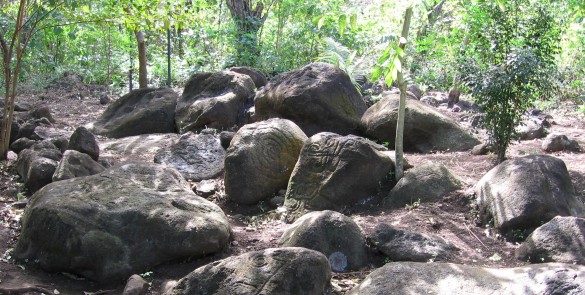
In the late 1990s, I trained as a field archaeologist. For the better part of a decade, I was part of a merry crew that roamed the forests and mountains of the US, surveying for archaeological sites and excavating them. My work took me from the swamps of South Carolina to the high deserts of California, and many places in between. During this period of time, which I know refer to as “my twenties, God bless them,” I wondered about the role of intuition in discovering and interpreting archaeological sites. After all, archaeologists, and all researchers, make decisions based on gut feelings and intuitive leaps that lead to new discoveries. However, we’re not really taught how to develop our intuitive abilities because this and other non-rational ways of knowing are swept under the methodological rug in our scientific culture.
This is a missed opportunity, to say the least.
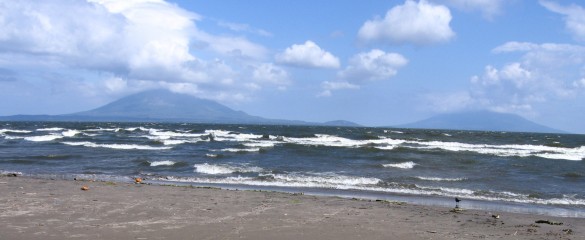
In 2006, I visited Ometepe Island in Nicaragua, home of one of the largest collections of undocumented prehistoric rock art in the world. During a month of volunteer fieldwork, I decided to put my ideas about intuition to the test by using lucid dreaming and nature observation techniques in the field to complement my empirical studies. I thought perhaps that these methods would help me discover my biases as I projected my imaginal realm onto an ancient rock art site.
But much more actually happened, and in some ways, what I learned is still unfolding. Basically, the stones taught me how to become more aware, spurring lucid dreams that taught me how to view the stones more authentically. It was a process of intunement.
Digging In
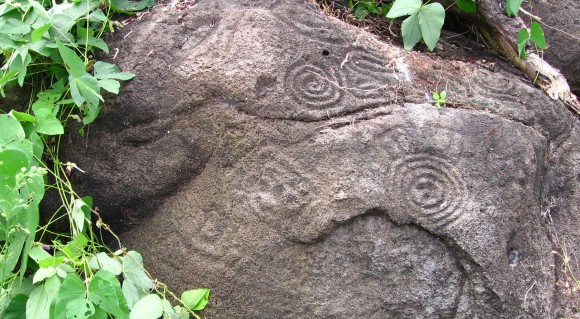
Ometepe Island is a volcanic island in the middle of Lake Nicaragua. The rock art is beautiful and mysterious, pecked onto basaltic boulders in centuries past by a number of pre-Columbian cultures. It’s full of spirals, circles, and abstract meanders, as well as animals and human figures. The entire island is sacred ground, topped by two enormous cone volcanoes. The cultural creators have long vanished, as Nicaragua has a devastating history of colonialism.
I stayed for a month at a coffee cooperative/hostel to record petroglyph sites. By the way, if you’re into excellent, organic, fair trade coffee that hasn’t been burnt to a crisp a la Starbucks, this roastery buys Ometepe beans and ships from Washington State. Proceeds support the island cooperative.
My field work opportunity was with the Ometepe Petroglyph Project. We did the usual site reports with standard recordation: sketches, photography and GPS mapping. Then, after the day’s fieldwork was over, I spent my evenings sitting at one particular petroglyph site close to the hostel.
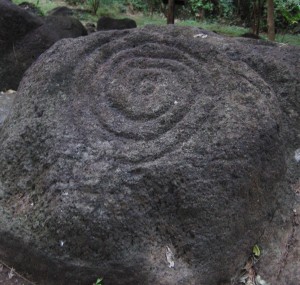
Over the next couple weeks, I re-recorded this site too, which has a collection of 20+ petroglyphs on a dozen or so boulders. Honestly, though, I spent more time with my notebook closed than open at this site. I soaked in all in, following the advice of writer and mythic cartographer Paul Devereux, who suggests in his 1992 book Earth Memory that ancient sites “can only be made by the observer becoming immersed in the sites, their positioning and their ambient topography.”
During my first visit, I was immediately drawn to a large spiral image on the edge of the site. It beckoned me to sit with it awhile. I did so, and the rock drew me into a quiet contemplation that I engaged in almost every day for the next two weeks. Then the lucid dreams about the rock art began.
A lucid dream:
“I see a pecked petroglyph – a long meander that I follow with my gaze. It’s not on a rock, just an image of a line that snakes around, coming into being as I follow it. Also, there is a strong feeling of texture, as if I am tracing it with my finger. But there is no dreambody– the best I can describe it is as if I am ’seeing‘ the texture, or feeling the vision. It is synesthesia.”
Crossing Thresholds
Ten days later, I was in the field, looking for a prerecorded site so we could GPS it. Along the way, we found some new petroglyphs. We had to laugh, and record these new ones too. The island is simply saturated with sacred art. I went off by myself, looking for more new glyphs. The sun was straight overhead so the boulders had no discernible markings. Then I had an impulse to touch one large flat stone with my fingers. I ran my fingers over the rough stone and detected a smooth spot in a slight depression. I followed it as it ran in a tight circle. Suddenly, a spiral motif suddenly appears to my eyes as my fingers found its contours. It rippled into view like a mirage.
Only later did I realize that this waking moment mirrored the dream I had the week before: “an image of a line that snakes around, coming into being as I follow it.” I believe this sort of occurrence, this doubling, is more than coincidence, but a kind of cognitive tuning made possible through my daylight meditations and nighttime dream incubations. The tactile image crossed a threshold, from my dream into my waking life.
These sorts of things happen all the time, but we’re usually not aware of them. By enacting the process of archaeodreaming, however, this anomaly—and many others—became consciously available to me. At the end of my trip, it’s no exaggeration to say I was a better field archaeologist and I felt intimately connected with the ancient art of Ometepe Island.
Lucid Dreaming as Shared Space
Lucid dreaming, the art of self-awareness during the dream, can be an opportunity to investigate the local landscape. It’s not about dream control, but about directing focus towards a desired object or concept, and then watching to see what happens once the wish is planted. So it’s more about setting an intention, and then witnessing and interacting with the results. What comes up in the dream space? What emerges?
In a ecopsychological context, these dreams are more than a “simulation” of the landscape, but can also be seen as real exchanges, the shared imaginal space between my awareness and the landscape.
Rock Art as Maps of the Mind
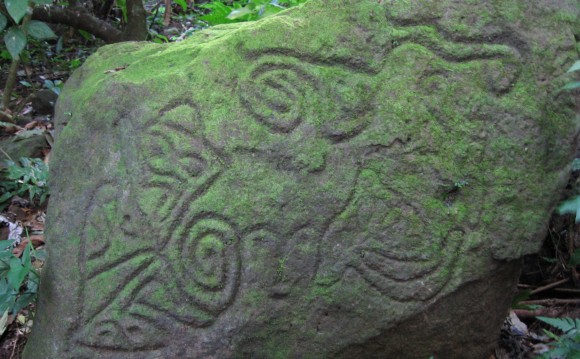
In this case, I was focusing on prehistoric rock art, which are cognitive artifacts that spring from the land and also from the minds of people long since gone. More so than heaps of ancient trash and crumbling walls, rock art expresses mental constructs and symbols that lay behind the day-to-day business of living. In this way, rock art gives up a unique glimpse into the structure of prehistoric minds and how cosmology constructs spaces and places.
The stones remember.
While dreaming of the stones did not show me cultural levels of understanding for this rock art (ie I’m not arguing for psychic archaeology here), the dreams did reveal to me more than my biases. They showed me some unique perceptions –anomalies–I had during the day that I had consciously rejected. Paired with the non-linear information gathering from my elongated site visits that incorporated nature meditations, the dreams provided a forum for my creative mind to interact with the unusual dimensions of the rock art site, relating it to the landscape through the senses.
Sacred Sites and Altered States
In other words, I became attuned to the site, so it could express itself in relationship to me. That’s what one criteria for what makes an archaeological site a sacred site: the intact ability for the site to still affect change in human consciousness. In this pilot study, these intuitive methods revealed the potential importance of the boulders’ acoustic profiles for shifting consciousness. The stones were pecked, and this sound could have produced desired trance effects for the glyph’s artists through acoustic driving.
As many archaeologists have correlated abstract geometric imagery with altered states of consciousness, the question here is what states of mind were encouraged, and how were they achieved? It’s just a theory at this point, but a testable one, and that’s the point: intuitive methods can lead to new falsifiable hypotheses.
I will provide more information about my method in a future post, as it’s easy enough to do if you are looking for a way to allow your mind a multi-dimensional access to sacred sites you are visiting, or any research project that you are deeply involved in.
This article is drawn from my essay “Dreaming with the Stones: the rock art of Ometepe Island,” in the anthology Rebearths: conversations with a world ensouled, edited by Craig Chalquist. An academic presentation of this project will be published in the March 2011 edition of the journal Anthropology of Consciousness, 22(1) as “Integral archaeology: process methodologies for exploring prehistoric rock art on Ometepe Island, Nicaragua.”
All images (c) Ryan Hurd 2011
Great piece Ryan, fascinating subject. In my experience intuitive methods like this can definitely bear verifiable fruit. And I agree, it’s less to to with “psychic archaeology” than allowing non-rational workings of the mind into your research.
I wonder how many “orthodox” archaeologists have been led to certain theories by this kind of thing – perhaps without admitting it, perhaps even to themselves?
thanks Gyrus. I wish I had read your Archaeologies of consciousness before embarking on this trip. Your exploration of cupules and sonic resonances however influenced my after-the-fact interpretations.
As for intuition in the field, I remember once asking the principal investigator of an excavation how he made a decision when, for example, he had room in the budget to put in only one more trench, and the testing data (artifact density, intact soil stratigraphy) was the same for several possible locations. how did he choose? he admitted, “blindly.” This is precisely where intuition can be developed and play a larger role. Make no doubt, intuition is already playing a role here, but it is largely unconscious.
Hi Ryan, Curt Hoffman, the IASD archeologist, took us to The Field of Dreams, a dig at a baseball field of ancient, sacred Native-American stones. The diggers were guided by their dreams to major finds! I was told in a dream,there at the IASD conference to “take the 1:30 bus, which was the visit to the site that Curt had arranged.
thank Lou for commenting! Hoffman is ahead of the curve for using dreams as a gateway to intuition; I’m excited that he has several essays in press relating to dreams and sacred sites. Hoffman also introduces my upcoming essay in the AOC journal with a history of cognitive archaeology.
I completely agree, Ryan – have had similar experiences with the stones in Brittany (esp. Gavr’inis), where I suddenly understood things about their stories by opening my intuition up to listening.
The stones in Hawaii similarly change consciousness – see my essay Kumu Pohaku: Stones as Teachers in So What? Now What? The Anthropology of Consciousness Responds to a World in Crisis. I think when we open to the land like this, it responds in kind like a friend.
thanks Tina! I like very much the idea of “opening” to the land, and inviting dialogue. I’m excited about the AOC paper, Mark Schroll just informed me that it’s going to the printer this week. Which reminds me I need to pay my AOC dues. 🙂
Ryan
Excellent and thought provoking article.
I got into rock art a couple of years ago after becoming interested in Australian Wanjina rock art. I got quite a shock when I found out the UK had its own indigenous rock art and visited sites at Roughting Linn and Ilkley Moor. I’m a big fan of of Devereux and have practised sitting in the landscape – although I have not yet tried to dream at sacred sites as Devereux investigated in the Dragon project.
However, you’ve gone one set further to bring interpreting rock art and lucid dreams together. It’s a fantastic idea and one I’m going to think more about. Thanks for your insight.
Fascinating topic. I found your article after a lucid dream about a sacred site , the magical feeling of that place i still carry it with me. This is an archeological site that i have visited in other dreams and i feel an urge to go back to, there os definitely a strong connection there. Your article gives me hope that i can learn more about this place and maybe it can guide me to the real physical place using some of your techniques. Thank you!